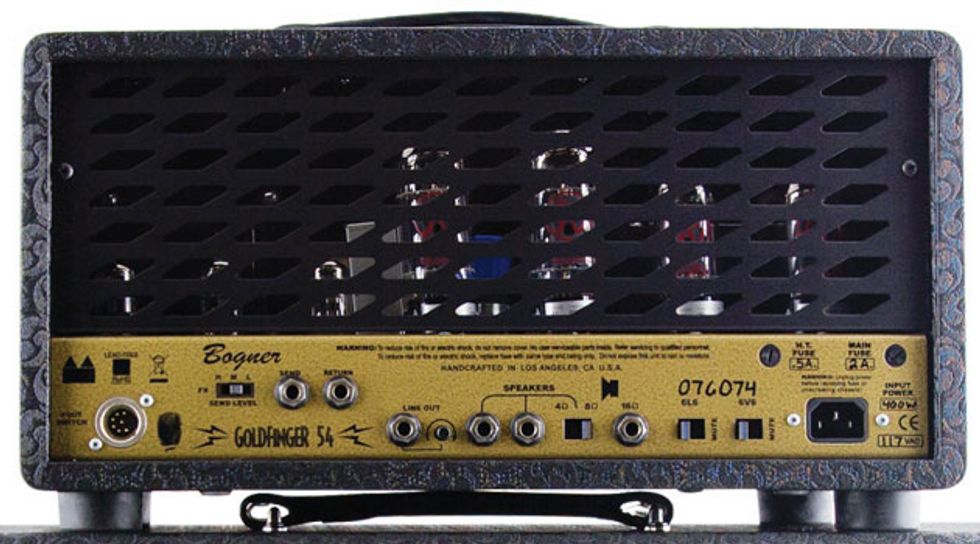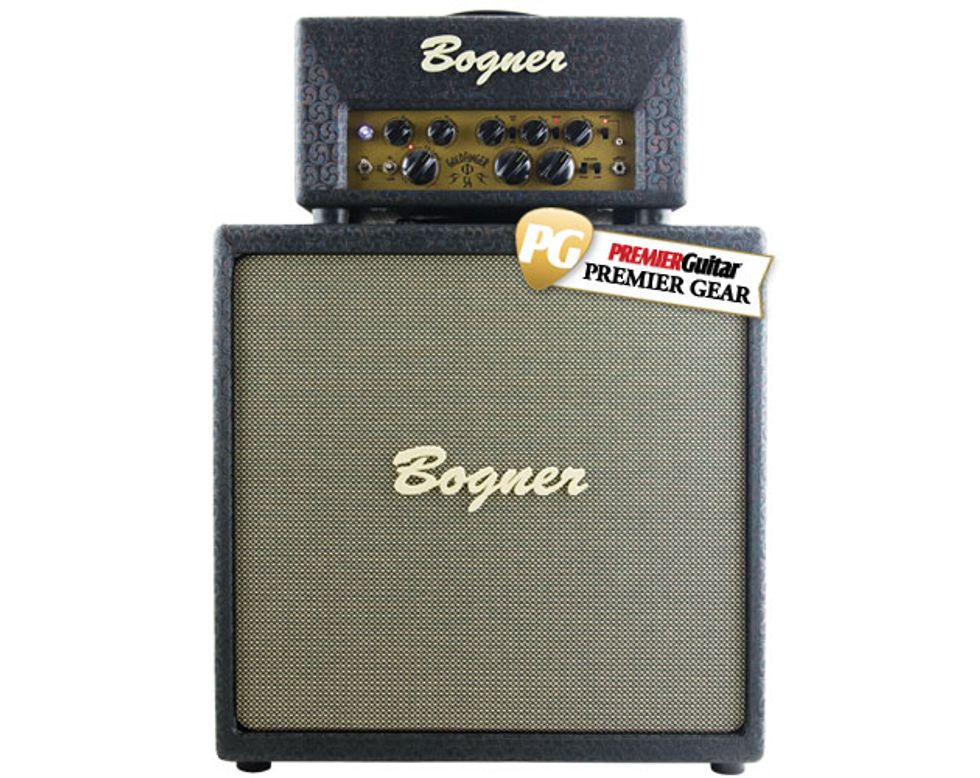Reinhold Bogner came to fame in the late-’80s, making and modding amps for the likes of Eddie Van Halen and Steve Vai. His Überschall, Ecstasy, and Shiva amps are a common sight on stages and in studios, and often modeled by digital engineers aiming at ideal high-gain tones. But while Bogner is known best for over-the-top, high-gain monsters, vintage sounds have long been a part of his mix. The new Goldfinger 54 Phi is the newest addition to the slightly mellower, tweed and blackface-inspired branch of the Bogner family tree.
Twin Tube Identities
The Goldfinger 54 Phi is a single-channel, vintage-style amp that’s, not surprisingly, derived from the original Goldfinger 45’s Alpha (clean) channel. At 30.5 pounds, this amp is light and very compact for a 70-watt amp. It’s outfitted with pairs of 6L6 and 6V6 power tubes, which can be used as pairs or combined into a burly four-power-tube array. The amp has low and high power modes. With just the 6L6 power tubes, the low setting yields 27 watts in low mode and 58 watts in high power mode. The 6V6 set generates 9 and 19 watts. All four power tubes together generate 33 watts in low and 66 watts in high modes. Tube combinations aren’t the only power-scaling paths. There’s also a high/low plate voltage switch that significantly shapes output and response.
the gain knob is set.
The Goldfinger 54 Phi is a lot more complex than its single-channel amp nature implies. In addition to the standard EQ, presence, and gain controls, the front panel features a switch that enables flicking between regular passive and Baxandall EQ configurations (the latter brings out the amp’s tweedier side), and two boost options (a fixed solo boost and a boost with an adjustable trim pot). The amp also comes with a 4-button footswitch, which lets you control reverb, the effects loop, and the two boost functions.
The Bogner Touch
I tested the Goldfinger Phi with the matching Bogner 2x12—a pine, open-back cabinet, outfitted with Celestion Greenback 25 and G12H30 speakers. In the 6V6 setting with the gain up around 3 o’clock, I expected a fair amount of grit. But, to my surprise, a fairly gentle open G-chord-based progression yielded a rich, very clean sound with just a spot of compression. The Goldfinger 54 Phi is incredibly touch-sensitive and overdrive is regulated as much by the player’s attack as the gain knob setting. When I really attacked the strings, the amp took on a different character entirely—more reminiscent of a particularly clean Fender tweed. Lower register notes on the low E-string growled without ever sounding flubby. Single notes higher up the neck sounded round and full.

The 6L6 setting has more headroom and the top end is a little less crisp than in the 6V6 mode (which inverts the traditional relationship between 6V6 and 6L6 circuits, in some respects). But the ability to control the amp’s character via pick attack remained, even with the gain cranked. At high gain levels I could get very clean sounds with a light touch. Only the amazingly long sustain from each note betrayed the amp’s high setting. Strumming hard, meanwhile, generated in-your-face grit that was still very tuneful and rich.
Pushing It
The Goldfinger 54 Phi gives you two boost options: a fixed mid boost (called solo boost) and a regular adjustable boost. The significant sonic differences between the two account for much of the amp’s versatility. Step on the solo boost and the amp gets a jolt of volume and dirt, sounding a lot like a blackface amp running at high volume. But add the regular boost (with the boost trim pot set around 4 o’clock) on top of the solo boost and the amp turns into a grinding, fat rock ’n’ roll machine, dishing creamy, relatively uncompressed overdrive.
Ratings
Pros:
Incredible tones, tons of tone-shaping options. High headroom.
Cons:
Reverb can only be activated via footswitch.
Tones:
Ease of Use:
Build/Design:
Value:
Street:
$2,249
Bogner Goldfinger 54 Phi
bogneramplification.com
Even with both boosts stacked, the 54 Phi never gets into crazy high-gain territory. But if that’s a concern, it’s worth noting that the Goldfinger 54 Phi makes a fantastic pedal platform. I rigged together a chain of effects including Hermida Audio Zendrive, Rockbox Boiling Point, and Pro Co RAT pedal for dirt, and a Line 6 M5 Stompbox Modeler for delays, and got excellent results, including filthy high-gain crunch.
Tweaker’s Delight
The Goldfinger 54 Phi offers broad tone-sculpting capabilities. The expand section gives you additional EQ controls in the form of high and low switches, which add brightness or a fatter bottom end. I particularly liked how the low switch beefed up my single-coil sounds.
Another unique feature of the Goldfinger 54 Phi is the Bax EQ switch. In Bax mode the tone stack is reconfigured to emphasize the midrange. There’s a noticeable drop in volume and a touch of hollowness to the overall tone when the Bax EQ is engaged, and the amp also felt a little less dimensional. But the tradeoff is clarity and articulation that can be a much better fit for a live band mix. The BAX mode is not meant to be switched back and forth. When it's engaged, the EQ, gain, and volume controls need to be readjusted.
Regal Reverb
The Bogner’s DSP reverb is excellent. From about noon on, it introduces a modulation effect that adds extra movement and air, and it’s simply gorgeous. But even generous amounts of the effect do not obscure your guitar tone or sound too washed out. If you opt to use a delay, the footswitchable, tube-buffered effects loop can be set so you hear delay trails when you disengage it. It’s a pretty cool feature, though the fact that you have to remove the back panel to access the toggle switch is a minor inconvenience.
The Verdict
There’s a lot to love about the Goldfinger 54 Phi. Clean sounds are full of character and the two boosts offer great overdriven colors. And even though it’s a single channel amp by design, the various EQ and boost options create enough tone possibilities to create option anxiety. The good news is that the Goldfinger 54 Phi sounds great at almost any setting. It’s really one of the better sounding amps I’ve come across in recent years.







![Rig Rundown: AFI [2025]](https://www.premierguitar.com/media-library/youtube.jpg?id=62064741&width=1245&height=700&quality=70&coordinates=0%2C0%2C0%2C0)












 Shop Scott's Rig
Shop Scott's Rig![Devon Eisenbarger [Katy Perry] Rig Rundown](https://www.premierguitar.com/media-library/youtube.jpg?id=61774583&width=1245&height=700&quality=70&coordinates=0%2C0%2C0%2C0)














 Zach loves his Sovtek Mig 60 head, which he plays through a cab he built himself at a pipe-organ shop in Denver. Every glue joint is lined with thin leather for maximum air tightness, and it’s stocked with Celestion G12M Greenback speakers.
Zach loves his Sovtek Mig 60 head, which he plays through a cab he built himself at a pipe-organ shop in Denver. Every glue joint is lined with thin leather for maximum air tightness, and it’s stocked with Celestion G12M Greenback speakers.








